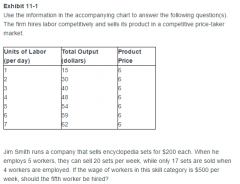![]()
![]()
![]()
Use LEFT and RIGHT arrow keys to navigate between flashcards;
Use UP and DOWN arrow keys to flip the card;
H to show hint;
A reads text to speech;
19 Cards in this Set
- Front
- Back
|
The marginal revenue product of a resource:
|

|
|
|
For a competitive firm, workers' marginal revenue product equals the marginal product of labor times the: - wage rate. - price of the firm's product. - interest rate. - firm's total revenue. |
price of the firm's product. |
|
|
Suppose a monopsonist wants to hire more workers. If it has to pay the same wage to all of its workers, the:V |

|
|
|
When Harlan County, Kentucky, has a monopsony coal mining firm, |

|
|
|
An increase in the demand for a product will shift the demand curve for labor producing the product to the right. t/f |
True |
|
|
Marginal revenue product of labor measures the extra revenue generated to the firm from the employment of an additional worker. t/f |
true |
|
|
Other things equal, assume consumer demand for children's toys increases. The result is a(n):
|

|
|
|
A monopsonist's marginal factor cost (MFC) curve lies above its supply curve because the firm must: |

|
|
|
Assume consumer demand for CD-ROMs increases. The result is a(n): |

|
|
|
If product price increases, then: -MP will increase. - MFC will increase. -MRP will increase. -MP will decrease. |
MRP will increase. |
|
|
If the price of labor falls, we can expect: |
quantity demanded of labor will increase. |
|
|
What happens to the MP of labor when the market price of the good produced increases? |
STAYS THE SAME |
|
|
If a town has a monopsony, this means: |
ONLY ONE EMPLOYER |
|

|

|
|

|

|
|
|
A union may attempt to obtain stricter certification requirements or longer apprenticeships. These changes would raise workers' wages because they:
- create unnecessary unemployment - shift in labor supply curve leftward. - decrease the marginal product of labor. = reduce management's use of featherbedding. |
shift in labor supply curve leftward.
|
|

|

|
|
|
Which of the following can shift the labor demand curve to the right?
- Decrease in product price. - Increase in wages. - Decrease in wages. -Decrease in the MP. -Increase in productivity.
|
Increase in productivity.
|
|
|
Union membership as a percentage of the civilian labor force is lower in the United States than in Germany or Japan. T/F |
TRUE |

